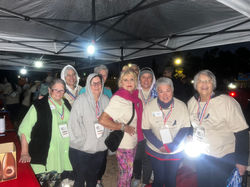
Phoenix, Arizona
 |  |  |  |  |  |
|---|---|---|---|---|---|
 |  |  |  |  |  |
 |  |  |  |  |  |
 |  |  |  |  |  |
 |  |  |  |  |  |
 |  |  |
The History of Sodality
Saint Thomas the Apostle Catholic Church welcomed it’s first parishioners in November of 1950. In 1951 several women in the parish applied for a charter and established Our Lady of the Assumption Sodality, continuing the tradition as ‘a religious body which aims at fostering in its members, an ardent devotion, reverence, and love towards the Blessed Virgin Mary’, a society which began in 1563.
From May 1951 until today this organization has continually served our parish and community.
The Sodality of Our Lady (also known as the Blessed Virgin Mary) is a Roman Catholic Marian Society founded in 1563 by Belgian Jesuit, Jean Leunis, at the Roman College of the Society of Jesus.
Fr. Jean Leunis, while instructing a group of boys,’ is inspired by not only their energy but sees something special in them; a power and enthusiasm which, if inspired and directed, could perform immense things for God. He is to teach the boys’ the classics but also, a love for God and zeal for souls. The boys are captivated by his every word and enlist to be a knight of our Lady – her perpetual servant. To put on her white armor; to be a mighty Knight, with the goal to aim high – a star to guide them through the storms of life.
They knelt to pray and consecrated themselves to Our Lady. What began in a simple classroom; with only one Jesuit priest; with only a small band of boys and their small act of devotion caused untold millions of people/souls to have their petitions heard through the fundamental motto: “To Jesus through Mary.” Their dual purpose of Sodality was and still is today, personal sanctification and apostolic work. A Sodalist – derived from the Latin word sodalist – is a close friend, companion or someone who shares a common interest.
It was the birth of the Sodality of Our Lady. It spread through every country of Europe, gathering under the banner of Mary, Our Lady. Kings, Queens, Emperors, Popes, and Saints: millions of souls have been led upwards and onwards by the personal sanctification to Mary, Our Lady. Fr. Jean Leunis and his students could not have imagined that they were calling into being one of the most enduring apostolates of God and the salvation of souls.
The first student Sodalists followed a strict routine in practicing their faith through the sacrament of confession, attending mass, and receiving communion. They prayerfully meditated and recited the rosary. Their development of personal piety bore fruit in their work for others, and the service of the poor. It was their first success in Catholic Action.
Protestantism was growing in population in Europe when Sodality made its small entrance into the world. The last and most threatening assault of the first Red Peril, Mohammedanism, was streaming down upon Christian Europe in a final effort to raise the crescent above the cross. Those were dark days for the Church which threatened the fall of the Catholic Church. “Thou art Peter, and upon this rock I will build my church; and the gates of hell shall not prevail against it.” (Matt. 16:18.)
The Roman College Sodality was favored in 1577, with indulgences granted to it by the Sovereign Pontiff, Lucien the IV. Sodality spread everywhere, and the good it was doing led the General of the Society of Jesus, Fr. Cladius Acquiviva, a previous Director of Sodality, to ask Pope Gregory XIII to make the Sodality at the Roman College what is called a head Sodality or primaria – that is, a mother Sodality which can communicate to others affiliated with it the privileges and indulgences possessed by itself. The Pope did this, in the Bull Omnipotentis Dei issued on December 5th, 1584.
Other Popes increased the powers and privileges of the Sodality. The most remarkable being, the Bull, Gloriosae Dominae (Queen of Heaven and Earth) of Pope Benedict XIV. It is known as the “Golden Bull” because, in token of special honor for the mother of God, the seal was not, as is customary, of lead, but of gold.
The growth of Sodality was not confined to students at Jesuit Colleges but had a far greater reach to men from all vocations in life. Soon there were Sodalities of priests, of nobles, of merchants, of workingmen, of clerks, of married men, unmarried men, of soldiers, each confined to a particular class of people. All affiliated to the Prima-Primaria Sodality in the Roman College.
It is interesting to note that for one hundred and sixty-seven years of the Sodality's existence - that is, from 1584 to 1751 - the membership was open only to men. It was only in 1751 that Pope Benedict XIV gave leave to aggregate Sodalities of married women and girls. A great increase in membership was the result. Such, too, was the outcome when, in 1825, Pope Leo XII granted affiliation to Sodalities not under Jesuit direction.
The Sodalities so founded and aggregated to the Prima-Primaria worked to form goodness and piety to over twenty-five million people/souls from their foundation to present day. People of all levels of life joined, contributed their time and apostolic works in their desire to honor the Virgin Mary. From Popes, Cardinals, Archbishops, Kings, and lay people; the goal was “To Jesus through Mary.” Others, who made it to sainthood were also Sodalists.
The first of Sodality rules makes it clear that: the Sodality “is a religious body which aims at fostering in its members, an ardent devotion, reverence, and love towards the Blessed Virgin Mary”. Through this devotion, and with the protection of so good a Mother, it seeks to make the faithful gathered under her name good Catholics, sincerely bent on sanctifying themselves, each in his state of life, and zealous, as for as their condition in life permits, to save and sanctify their neighbor and to defend the Church of Jesus Christ against the attacks of the wicked.”
The primary rule of the Sodality entails, that the zeal for interior sanctity should abound, too, in work for the neighbor. A well-organized Sodality will have different committees, each devoted to a form of Catholic Action. Each Sodalist may choose the one whose activity best suits his/her opportunities and inclinations. Examples of this may be: Caring for the Sacramental Linens, working with St. Vincent de Paul Society, Social Action, and more.
Sodality in fact, has a wide range of work awaiting its services as to live up to its traditions and possibilities. The feeding and clothing of the poor; catechetical instruction; help in preparation of Baptism; Communion; Confirmation of those in need or of lapsed Catholics; the case of late vocations to the priesthood or religious life; work on behalf of the missions; a vigilance committee that will study the tone of periodicals; the stage, the cinema; a section of writers or the production of plays; a section of doctors and dentists who give their services to the poor and study Catholic ethics; a section that will look after the housing of the poor and homeless – such activities await Sodalists who strive to be worthy brothers or sisters of Christ.
Currently, there are Sodalities for priests as well as lay-people, Sodalities for physicians, lawyers, teachers, nurses, schools, and universities. Today the majority of Sodalities are in parishes served by Diocesan priests and priests of other religious orders.
So, “To Jesus Through Mary” is truly an amazing journey to follow to increase your faith and to humbly serve your parish and community.